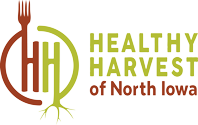Food Access Meets Food System Development in North Iowa: A Community-Driven Path Forward
In March, Healthy Harvest of North Iowa and regional partners coordinated a Food Access and Food Systems Development tour across Wright and Hancock counties. Organized by Executive Director Andrea Evelsizer and Jan Libbey of Kanawha, the tour brought together local and state leaders—including Representative Mark Thompson, Senator Dennis Guth, Wright County Supervisor Ashley Bosch, and Wright County Economic Development Director Darrel Steven Carlyle—alongside food access champions and community advocates.
A Ground-Level Look at Local Solutions
The first stop was the Clarion Food Pantry, where attendees discussed the vital role that food hubs—like Prudent Produce—play in connecting Iowa farmers with programs like the now-defunded USDA Local Food Purchasing Assistance Program (LFPA). These hubs provide essential infrastructure for aggregating and distributing food from hundreds of Iowa’s small and mid-sized producers.
At Wright County Community Connections, Cole Lindeman shared plans for a new indoor hydroponic system that will grow leafy greens year-round. To be installed this summer, the system will supply local markets, support educational programming, and generate revenue for the center. Cole highlighted the potential to repurpose unused buildings in rural towns for similar systems—offering young entrepreneurs a path to revitalize communities and strengthen local food supply chains.
In Hancock County, the final stop was Purple Ribbon Beef’s new retail store, made possible in part by the Choose Iowa Value Added Grant Program. The store now aggregates and showcases products from dozens of Iowa food and farm businesses—many without other retail access—creating a new model for economic opportunity and community food resilience.
The Broader Context
These local solutions are emerging at a critical time. More than one in thirteen Iowans face hunger, and 111 rural communities across the state are classified as food deserts. From 2010 to 2022, Iowa saw a 23% increase in households led by seniors falling below the ALICE (Asset Limited, Income Constrained, Employed) threshold. Meanwhile, younger generations are returning to rural Iowa to build farms and food businesses—often without the infrastructure or support they need to thrive.
The recent, abrupt end of USDA’s LFPA and Local Food for Schools (LFS) programs has only deepened the challenges. These initiatives provided food for vulnerable Iowans by purchasing directly from Iowa’s small-scale producers. Their cancellation leaves a significant gap in both food access and local production capacity.
“Spending time with policymakers to share and discuss these community connections takes our advocacy to another level,” said Andrea Evelsizer, Executive Director of Healthy Harvest of North Iowa. “We are building trust and awareness and strengthening relationships that give us a deeper level to return to policy discussions.”
What’s Next?
By aligning food access efforts—like food banks and schools—with local food production and market development, North Iowans are forging a more connected, resilient food system. With continued investment from programs like Choose Iowa Purchasing Program, Double Up Food Bucks, and the proposed Grocer Reinvestment Fund, these community-led innovations can scale and sustain impact.
Want to get involved? Learn more about advocacy efforts iowafoodsystemcoalition.org, follow the Iowa Food System Coalition, and join advocacy events to help shape policy solutions that serve Iowans from the ground up.






